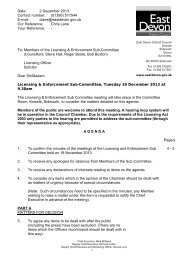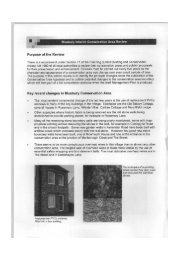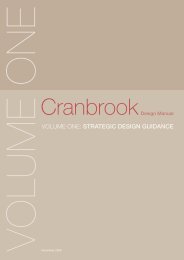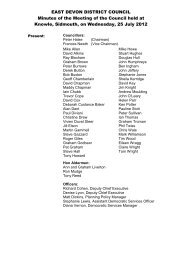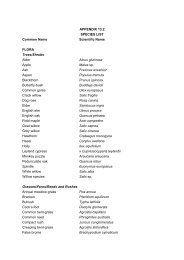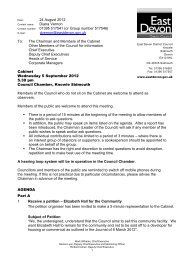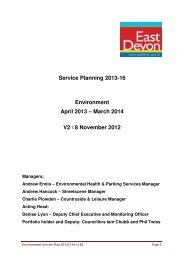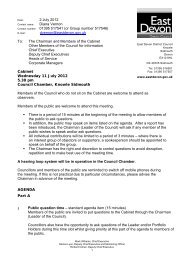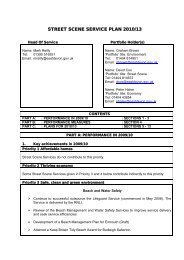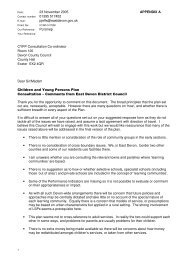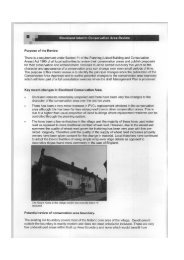Water Cycle Study - East Devon District Council
Water Cycle Study - East Devon District Council
Water Cycle Study - East Devon District Council
You also want an ePaper? Increase the reach of your titles
YUMPU automatically turns print PDFs into web optimized ePapers that Google loves.
Exeter and <strong>East</strong> <strong>Devon</strong> <strong>Water</strong> <strong>Cycle</strong> <strong>Study</strong><br />
Exmouth Maer Lane<br />
6.4.12 There is no consented capacity for growth at Exmouth Maer Lane WwTW as the flow<br />
consent is breached by the 2011 (500 dwellings) growth projections. In terms of water<br />
quality consents, as this is a tidal discharge with UV, the water quality consents are<br />
unlikely to require changing.<br />
6.4.13 The Environment Agency is currently in advanced discussions to determine a new consent<br />
application for Exmouth Maer Lane WwTW, which will increase the consented dry<br />
weather flow to a value in excess of the flow forecasted for 2026 by this study (Table<br />
6.2). The Environment Agency has made the necessary assessments (based on a design<br />
horizon of 2016-2021) and awaits formal submission of the consent application.<br />
6.4.14 Any further spatial allocation at either Exmouth or Budleigh Salterton will require that<br />
this variation of the existing consent at Exmouth Maer Lane WwTW is granted by the<br />
Environment Agency, and that South West <strong>Water</strong> plan for the implementation of any<br />
associated infrastructure capacity improvements in advance of, or in phase with<br />
development.<br />
Colyton<br />
6.4.15 Colyton WwTW has consented capacity for growth up to 2016 (500 dwellings) however<br />
our calculations forecast that the flow consent will be breached by 2021. Colyton<br />
WwTW discharges to the River Axe (approximately 75m upstream of Axe Bridge on the<br />
A3052), via a long outfall line. The River Axe is currently at moderate physiochemical<br />
status and is at poor biological and ecological status. Therefore the BOD consent may<br />
require tightening to meet WFD good status. There is no ammonia consent currently set<br />
at this WwTW .<br />
6.4.16 The EA state in their response to the Draft RSS Panel Report [EA 2006] that although<br />
they have concerns regarding the River Axe already failing its phosphate standard, due to<br />
recent nutrient stripping initiatives, they consider that there is capacity for the levels of<br />
development proposed in the catchment.<br />
Honiton<br />
6.4.17 Honiton WwTW has the consented capacity for all projected growth up to 2026.<br />
Honiton WwTW discharges to the River Otter which meets WFD good status in terms<br />
of physiochemical status, however it is classified as poor for both biological and ecological<br />
status. It is not considered that the WwTW discharge is the cause of the poor ecological<br />
status. However, should further assessment determine that the WwTW does contribute<br />
to the poor status, a quality consent might be needed. This should not be considered a<br />
barrier to growth at the scale planned, and any improvements will be identified through<br />
the RBMP process.<br />
Ottery Town<br />
6.4.18 Ottery Town WwTW has the consented capacity for all projected growth up to 2026.<br />
Currently there is a BOD consent of 30 mg/l and no ammonia consent has been set.<br />
Ottery Town WwTW discharges to the River Otter which is moderate in terms of<br />
physiochemical status and classified as poor for both biological and ecological status. To<br />
meet WFD good status WwTW improvements may be needed and a tighter quality<br />
59 Ref EWCS April 2010




